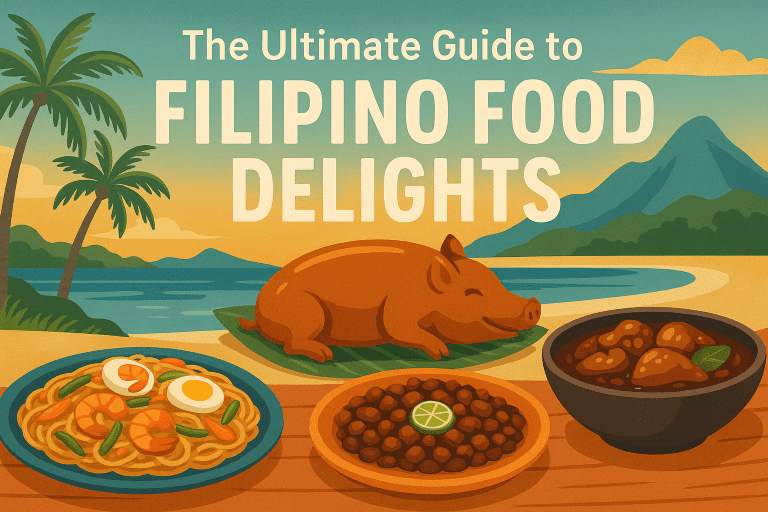
From the bustling street stalls of Bangkok to the tranquil villages in the North, Thai food offers a window into the local way of life. Yet, like any deep exploration, there can be unexpected encounters. While much of Thai cuisine is widely accessible and universally enjoyed, there are certain dishes that stand out due to their unique preparation, intense flavors, or unconventional ingredients – dishes that some travelers seeking authentic experiences might try, only to discover they fall outside their culinary comfort zone.
Thailand’s culinary landscape is profoundly influenced by its geography and history. The four main regions—North, Northeast (Isaan), Central, and South—each contribute distinct ingredients, techniques, and flavor profiles. Central Thai cuisine, with its balance of sweet, sour, salty, and spicy, is perhaps the most familiar internationally. Northern Thai food often features milder curries, sticky rice, and unique herbal sausages.
Southern Thai dishes are known for their spiciness and reliance on coconut milk and seafood. Isaan cuisine, however, stands apart with its strong flavors, including fermented ingredients, fresh herbs, chili heat, and an emphasis on sticky rice as the primary starch. It is often within Isaan’s bold culinary traditions that travelers are most likely to encounter dishes that challenge conventional Western palates.
Our goal isn’t to discourage exploration entirely, but to provide objective information so you can make informed choices based on your own comfort level, allowing you to still savor the essence of Thai culture through its more accessible, yet equally authentic, alternatives.
1. Larb Luu (Raw Minced Meat Salad with Blood)
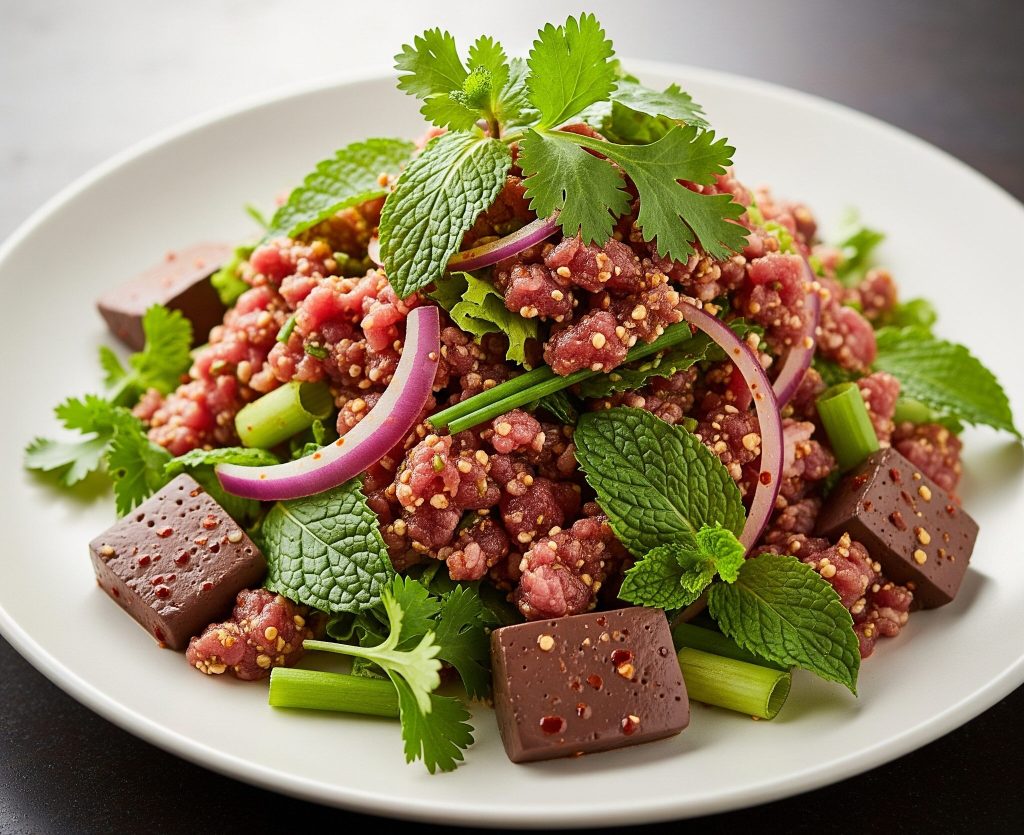
One dish that frequently appears on lists of challenging Thai foods, particularly from the Isaan and Northern regions, is Larb Luu. This dish is a variation of the ubiquitous Larb, a salad of minced meat often flavored with lime juice, fish sauce, herbs, chili, and toasted rice powder. However, Larb Luu takes a significant departure by using raw, uncooked minced meat – typically pork or beef – and, crucially, incorporating raw blood, sometimes mixed with bile for a bitter counterpoint.
The visual presentation alone can be startling to the uninitiated. The dish presents as a dark red, sometimes almost black, mass of finely minced meat mixed with a vivid crimson liquid (the blood). The aroma is distinct; beyond the expected herbaceous notes from mint, cilantro, and spring onion, there can be a subtle, metallic undertone from the raw blood, sometimes amplified by the pungent, earthy aroma of bile if used.
Culturally, Larb Luu is a dish deeply rooted in rural traditions, often prepared and shared during communal gatherings or celebrations. It represents a way of utilizing fresh meat quickly after slaughter, a practice common before widespread refrigeration. For locals, the raw ingredients and the distinct flavor profile, including the bitterness from bile, are not just accepted but often highly prized elements of the dish, offering a different sensory experience than cooked meat.
For tourists, the primary concerns often revolve around the texture of raw meat and the potential health risks associated with consuming uncooked animal products, especially street food. The flavor profile, with its combination of sour lime, spicy chili, savory meat, and the unique notes from raw blood and bile, can also be overwhelming. It’s a powerful, visceral dish that demands a palate accustomed to such intensity and rawness.
Safer Alternative: If you want to experience the iconic flavors of Larb without the raw aspect, opt for the much more common and widely available Larb Moo (pork) or Larb Gai (chicken). These versions use minced meat that is cooked, typically by simmering briefly in a small amount of water or broth until opaque and crumbly. The cooked meat is then mixed with the same vibrant dressing of lime juice, fish sauce, chili flakes, toasted rice powder (khao khua), mint leaves, cilantro, spring onions, and sometimes shallots.
Pair it with sticky rice as is traditionally done, or with jasmine rice, and enjoy the harmonious blend of flavors that makes Larb a national favorite, without the potential unease of consuming raw ingredients.
2. Goong Ten (Dancing Shrimp Salad)
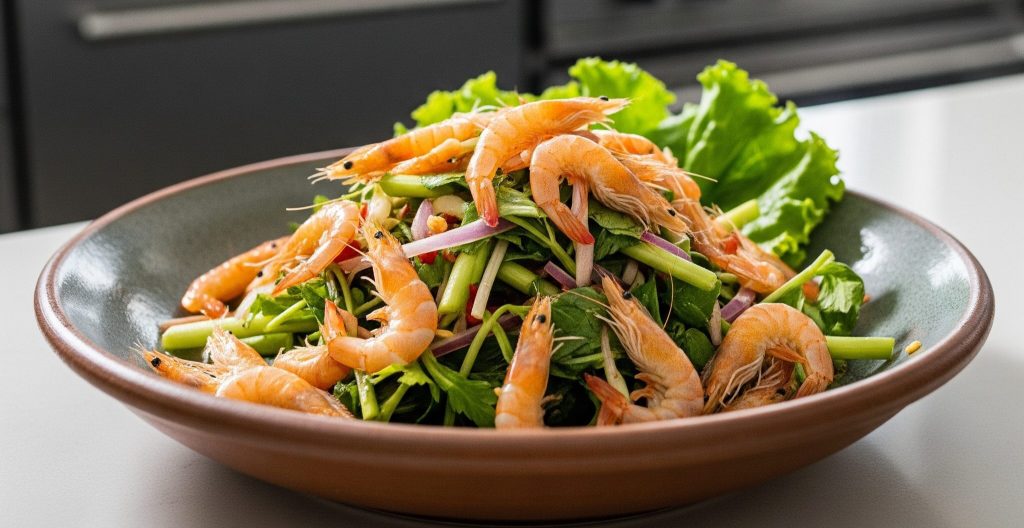
Imagine a salad where the main ingredients are still moving. That’s the reality of Goong Ten, which translates literally to “dancing shrimp.” This Isaan dish consists of small, live freshwater shrimp mixed with a spicy and sour dressing right before serving. The shrimp, reacting to the acidic dressing, visibly jump and wriggle in the bowl, hence the name.
Visually, the dish is dynamic and confronting. Small, translucent shrimp are served in a mixture of chopped herbs like mint and cilantro, sliced shallots, chili flakes, fish sauce, and a generous squeeze of lime juice. The distinctive preparation sound is the light popping and scraping as the shrimp move against the bowl and each other. The aroma is primarily that of a pungent, spicy, and sour dressing, with a faint, fresh, almost briny smell from the live shrimp.
The texture is the most challenging aspect for many: a combination of soft bodies and the unexpected sensation of them moving on the tongue. The flavor is intensely sour and spicy, designed to overpower any potential ‘raw’ taste from the shrimp, but the overall experience is intrinsically linked to the fact that the shrimp are alive when eaten.
Safer Alternative: If the idea of raw shrimp is less concerning than the ‘dancing’ part, Goong Chae Nam Pla offers a taste of raw shrimp texture but with dead, often marinated shrimp. Fresh, raw shrimp are butterflied and arranged beautifully, then topped with a potent mixture of fish sauce, lime juice, garlic, chili, and sometimes bitter melon slices. The texture is soft and slightly gelatinous, and the flavor is intensely savory, sour, and spicy, similar to the dressing used in Goong Ten but without the movement.
For a completely safe and widely loved option, Yum Talay (Spicy Mixed Seafood Salad) is an excellent choice. This salad features a variety of cooked seafood – shrimp, squid, mussels – mixed with glass noodles or fresh vegetables and dressed in a tangy, spicy lime-based dressing with fish sauce, chili, and herbs.
3. Pla Ra (Fermented Fish Sauce or Paste)
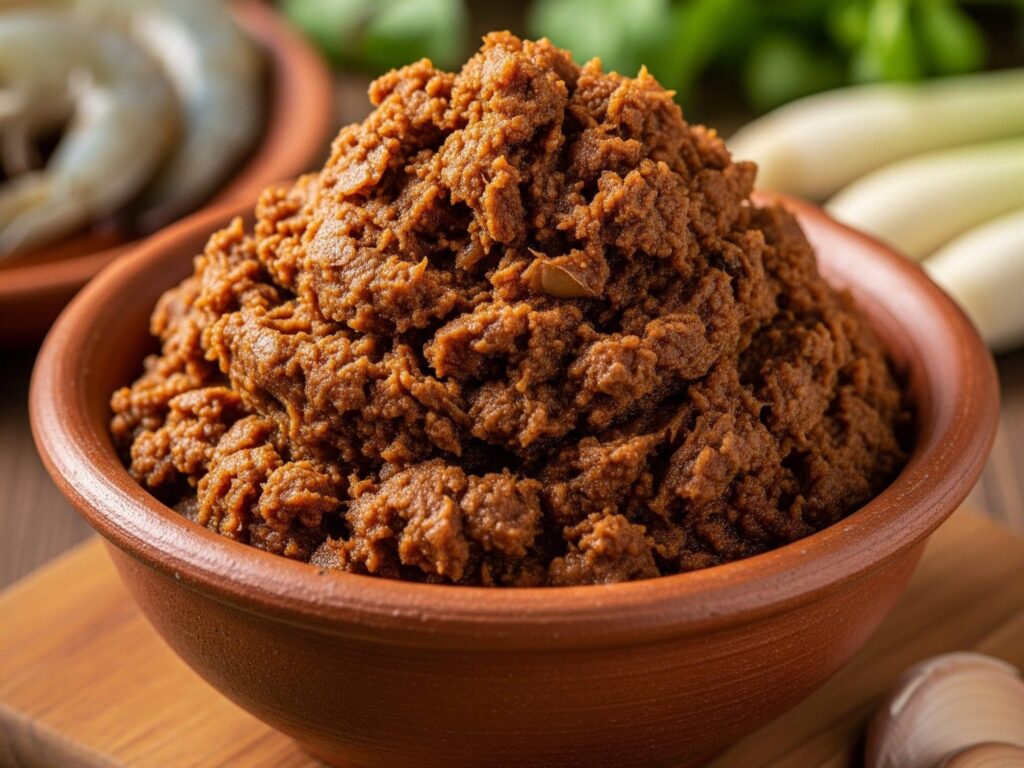
Pla Ra, also known as Pla Daek in Laos and parts of Isaan, is arguably one of the most challenging ingredients for foreigners in Thailand due to its extremely pungent aroma. It’s a traditional seasoning produced by fermenting fish, typically snakeskin gourami or other freshwater fish, with rice bran or roasted rice flour and salt in a closed container for months, sometimes even years. The resulting product can be a murky liquid or a thick paste, depending on the method and duration of fermentation.
The aroma is the primary hurdle. It is intensely savory, deeply fermented, and often described using words like ‘earthy,’ ‘funky,’ or even ‘rotten’ by those unfamiliar with it. It permeates the air and can be detected from a distance, particularly when heated during cooking. The flavor is similarly intense: profoundly umami, salty, and complex, adding a unique depth to dishes. The texture, if encountered as a paste, can be grainy or chunky from dissolved fish bones.
A common scenario for tourists involves ordering Som Tum and unknowingly receiving the Pla Ra version, expecting the familiar savory-sour-spicy balance of the standard Som Tum Thai.
Safer Alternative: For those new to Thai cuisine, sticking to dishes seasoned with Nam Pla (standard fish sauce) is a much safer bet, it is also a fermented fish product, but the fermentation process typically uses different fish (often anchovies) and results in a much clearer liquid with a clean, salty, savory aroma and taste that is far less pungent than Pla Ra. It provides the essential umami foundation of many Thai dishes.
If you want to try Papaya Salad, specify Som Tum Thai. This version uses Nam Pla as the savory component, balanced with lime juice, palm sugar, chili, tomatoes, green beans, peanuts, and dried shrimp. The aroma is fresh, spicy, and nutty, and the flavor is a harmonious blend of sweet, sour, salty, and spicy, with the satisfying crunch of peanuts and shredded green papaya.
4. Larb Mote Daeng (Ant Egg Larb)
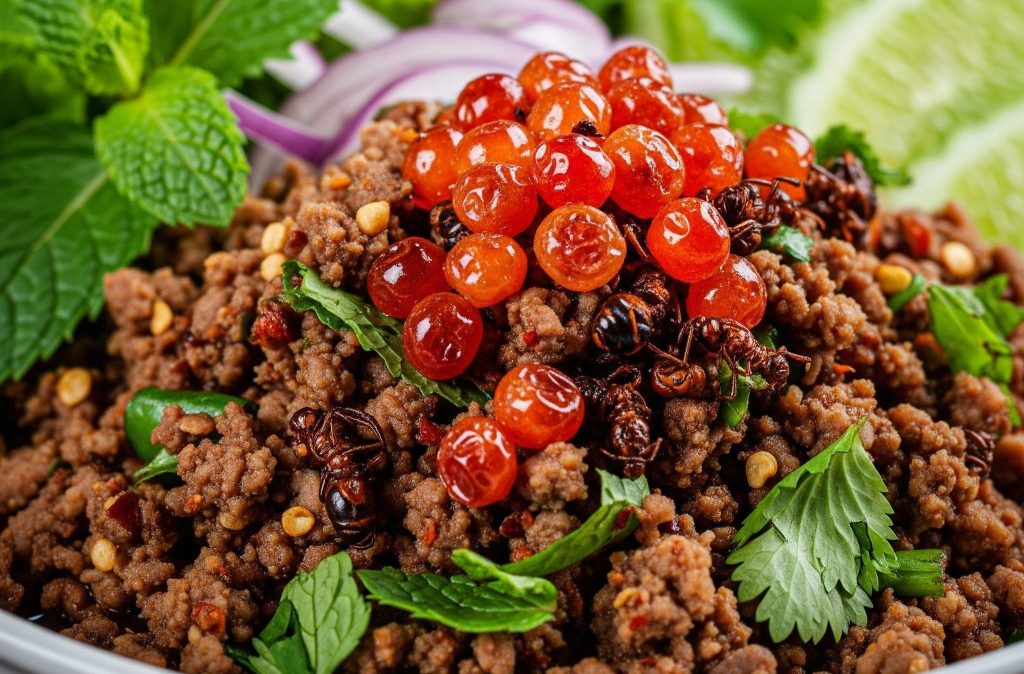
Yet another unique dish hailing from Isaan, Larb Mote Daeng features the eggs and sometimes the small larvae of red ants as the primary protein source, prepared in the style of a Larb salad. While insects and their eggs are consumed in various cultures globally, encountering them in a savory salad format can be unexpected.
The appearance of Larb Mote Daeng is striking due to the ant eggs themselves: small, opaque, off-white to pale yellow ovals, sometimes mixed with darker specks representing the ants or larvae. These are mixed with the standard *Larb* herbs, lime juice, chili, fish sauce, and toasted rice powder. The aroma is fresh and herbaceous from the mint and cilantro, with a distinct, sharp tanginess that comes from the natural acidity of the ant eggs.
The texture is the most notable characteristic. The ant eggs have a slightly firm shell that bursts upon biting, releasing a liquid interior. This creates a unique popping sensation in the mouth. The flavor profile is dominated by the sourness of the eggs, which is sharper and different from the sourness provided by lime juice alone, layered with the spicy, savory, and aromatic elements of the dressing.
For many tourists, the psychological barrier of eating insects or their eggs is the main challenge, compounded by the unusual popping texture and the specific sour flavor profile of the eggs themselves. It’s a dish that requires a significant degree of culinary adventurousness.
Safer Alternative: To experience Isaan flavors and textures that are less confronting, consider Sup Nor Mai (Spicy Bamboo Shoot Salad). This dish features boiled and shredded bamboo shoots dressed with Pla Ra (though you can ask if Nam Pla is an option at tourist-friendly spots, or be prepared for the Pla Ra), chili, toasted rice powder, and various herbs. It offers the characteristic Isaan flavors and the crunchy/fibrous texture of bamboo without any animal products that might be off-putting.
Another excellent and widely popular Isaan option is Sai Krok Isaan (Isaan Sausage). This fermented pork and rice sausage has a distinctive sour tang from the fermentation process, a savory depth, and a firm texture. It’s often grilled until the skin is crispy, providing a satisfying contrast to the tangy interior. Served with fresh cabbage, ginger, and chilies, it offers a true taste of Isaan’s unique flavor profile in a familiar sausage format. You can find delicious street food versions of this sausage in many parts of Thailand.
5. Durian (The ‘King of Fruits’)
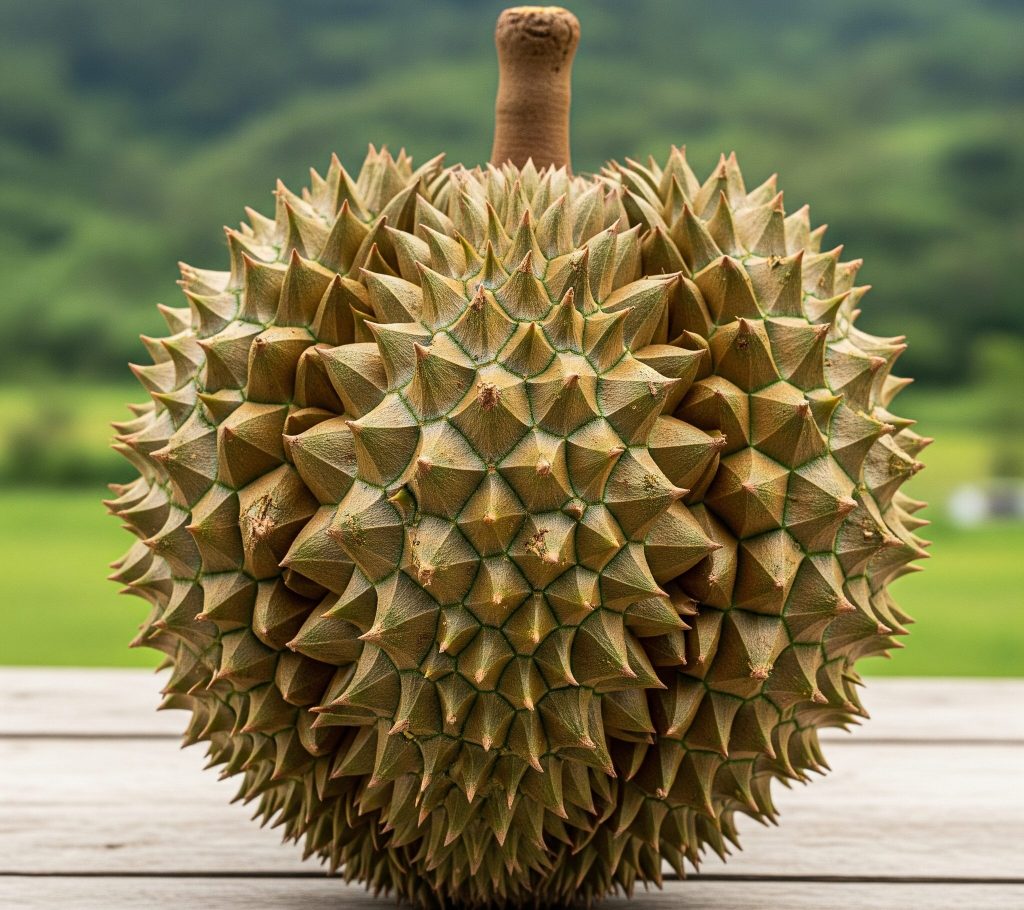
While not a prepared dish, the durian fruit itself is infamous for being one of the most polarizing and potentially “regrettable” food experiences for tourists in Thailand. Often called the “King of Fruits,” durian is large, spiky, and highly prized in Southeast Asia, but its odor is so potent and unique that it’s banned from many hotels, public transport, and airports across the region.
Visually, a ripe durian has a thick, thorny, greenish-brown rind. Inside, the edible flesh is segmented into pods around a central core, ranging in color from pale yellow to deep orange. The texture of the flesh is creamy and custardy, sometimes described as like a very ripe avocado or thick pudding, though firmness can vary between varieties.
The aroma is the defining characteristic and the source of its notoriety. It is complex and intense, often described subjectively in wildly different ways: some perceive it as sweet and fragrant, while others find it overwhelmingly sulfurous, like rotten onions, sewage, or strong cheese. This powerful scent lingers long after the fruit is eaten or removed from an area.
Culturally, durian is a fruit of status and celebration. Its high price reflects its desirability and the skill required to cultivate and harvest it. Sharing durian is a social activity, and the different varieties are discussed and appreciated by connoisseurs akin to wine or cheese enthusiasts in other cultures. According to a New York Times article, the durian market is significant and its cultural impact undeniable throughout the region.
For tourists, the intense, pervasive aroma is often the first barrier, making simply being near the fruit a challenge. If they overcome that to taste it, the unusual combination of sweet, savory, and creamy flavors with the distinct odor can be a jarring sensory overload.
Safer Alternative: For a guaranteed crowd-pleasing sweet Thai experience, opt for Mango Sticky Rice (Khao Niao Mamuang). This beloved dessert features sweet, ripe mango slices served alongside warm, sticky glutinous rice, all drizzled with rich, slightly salty coconut milk and often topped with crispy toasted mung beans. The aroma is pleasantly sweet from the mango and coconut, the texture is a delightful contrast between the soft fruit and chewy rice, and the flavor is universally appealing – a harmonious blend of sweet and creamy.
Alternatively, explore Thailand’s vast array of other delicious and less aromatic tropical fruits. Seek out fragrant rambutans with their juicy, sweet flesh; sweet and tangy passion fruit; refreshing and hydrating coconuts; or the many varieties of sweet, creamy mangoes available throughout the year.
Conclusion
Exploring the diverse culinary landscape of Thailand is one of the most rewarding aspects of visiting the country. While iconic dishes like Pad Thai, Green Curry, and Tom Yum Goong are justly famous and relatively safe bets for most palates, understanding these dishes, while potentially challenging for the uninitiated, are deeply rooted in regional traditions and represent the adventurous spirit of Thai cuisine.
Approaching Thailand’s food scene with an open mind and a willingness to try new things is key, but it’s also wise to be informed. Start with widely loved classics and gradually venture into more regional or unconventional items as your comfort level grows. Don’t be afraid to ask questions about ingredients or preparation methods, especially regarding raw or fermented components. Your culinary adventure in Thailand should be exciting, not anxiety-inducing. By being aware of dishes that might present a challenge and knowing their more accessible alternatives, you can navigate the vibrant world of Thai flavors confidently, ensuring your memories are filled with delight rather than regret.






